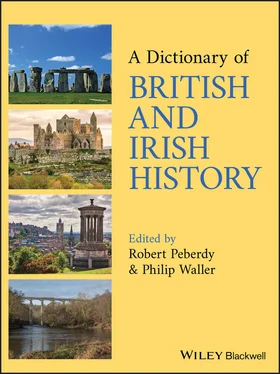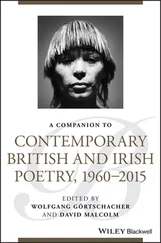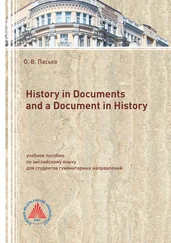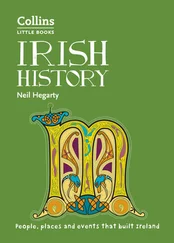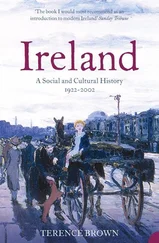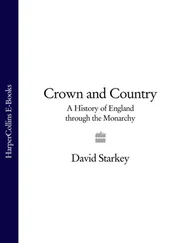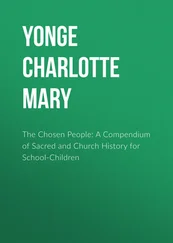In May 1940 Bevin was appointed minister of labour and national service in the wartime coalition government under Winston CHURCHILL and elected a Labour MP. As foreign secretary (1945–51), in the post‐war Labour government of Clement ATTLEE, he shaped British policy towards the COLD WAR (in defiance of left‐wing critics) while helping to implement MARSHALL AID and create NATO (NORTH ATLANTIC TREATY ORGANIZATION). His handling of PALESTINE was controversial. See also WORLD WAR II, IMPACT ON BRITISH ECONOMY.
BIBLE, ENGLISH
Parts of the Latin Bible were translated into Old English in the 8th–11th centuries (e.g., by ÆLFRIC), and in the 12th–14th centuries into Middle English, though latterly translation was discouraged. The first full translation was produced in OXFORD in the 1380s, influenced by John WYCLIF (d. 1384). Its association with heresy caused Convocation (Church assembly) to condemn it (1409) and prohibit unauthorized translations ( see LOLLARDY, ENGLAND; CENSORSHIP, ENGLAND AND WALES). William TYNDALE, who translated the New Testament from Greek and part of the Old Testament from Hebrew (1520s–30s), had to work abroad and was executed.
A favourable attitude developed after England’s break from papal jurisdiction (confirmed 1534). Miles Coverdale published a complete translation in Germany (1535), and in 1536 Thomas CROMWELL ordered churches to provide English Bibles. Coverdale’s version was reissued (1536); it was followed by Matthew’s Bible (1537, a compilation from Tyndale and Coverdale) and the Great Bible (1539, edited by Coverdale).
In 1560 English Puritans in Geneva (Switzerland) produced the popular Geneva Bible. Its radical commentary provoked Archbishop Matthew PARKER to commission the Bishops’ Bible (1568), a revision of the Great Bible. It was replaced in 1611 by a version ordered King JAMES VI/I ( see HAMPTON COURT CONFERENCE). Later known as the Authorized Version or King James Bible, it became regarded as a literary masterpiece. Meanwhile Catholics had produced the Douai–Reims Bible (New Testament 1582, Old Testament 1610).
The Authorized Version was revised in the late 19th century (published 1881–5, American Version 1901). Since then numerous new translations and versions have been made, including the Jerusalem Bible (1966) and New English Bible (1970). See also ANGLICIZATION, SCOTLAND.
BIBLE, IRISHElizabeth I, as ruler of Ireland, decided by 1564 that an Irish‐language Bible translation should be produced to encourage the conversion of Gaelic Irish people to Protestantism. The New Testament was published in 1603, translated from Greek by William Daniel (a Church of IRELAND archbishop). A translation of the Old Testament, organized by Bishop William Bedell, was completed in 1640 and printed in 1685. A complete Bible was issued in 1690. The translations were used by both Protestants and Catholics. A translation authorized by the Catholic Church, the Maynooth Irish Bible, was published in 1981. See also REFORMATION, IRELAND. BIBLE, WELSHExtensive translations first appeared in the 16th century, during the REFORMATION. William SALESBURY published Bible readings in 1551 and helped to obtain an Act of 1563 which required Welsh bishops to provide every parish with a printed Welsh Bible by 1567. That year saw publication of the New Testament, largely Salesbury's work. The entire Bible, translated or revised by William MORGAN, was published in 1588, and a revision in 1620 (by Richard Parry and John DAVIES). A new translation appeared in 1988. BICYCLES AND BICYCLE INDUSTRIES
Two‐wheeled, feet‐propelled ‘hobby‐horses’ were made in England from the early 19th century. A mechanically propelled bicycle, with treadles driving a rear wheel, was invented in 1839 in Scotland by Kirkpatrick Macmillan but not manufactured. Following developments in France, pedal‐driven bicycles were manufactured in England from the 1860s. Further advances included the chain drive (patented 1876) and tubular, diamond‐shaped frame (basis of so‐called ‘safety bicycle’, created 1884–5). Hard wheel rims made early machines uncomfortable.
Bicycles and cycling were transformed by the invention in 1887 of the pneumatic tyre (by Scotsman J.B. Dunlop, in BELFAST, NE Ireland). Bicycles with pneumatic tyres were manufactured in Ireland from 1889 (in DUBLIN), then in England where mass production rapidly developed, especially in the W Midlands. From the mid 1890s, people of all classes in Great Britain could purchase cycles, though in Ireland they remained luxury items until c .1918. Touring and racing became widespread, encouraged by clubs. In Ireland, the organization of sports cycling was fractured by national divisions and disputes after the PARTITION OF IRELAND (1921), lasting until 2006. British competitive cycling attained high‐profile success in the early 21st century – in 2012 Bradley Wiggins was the first British competitor to win the prestigious ‘Tour de France’ race.
In 1960, following a merger, Raleigh (at Nottingham, C England) became the world’s largest bicycle manufacturer. Its output declined severely in the 1980s due to overseas competition; volume production ceased in 1999. In the Republic of Ireland, bicycle manufacturing ceased in 1976 (burning of Raleigh factory, Dublin) but was revived in 2014.
BIG BANGNickname for reforms to the LONDON Stock Exchange, implemented 27 Oct. 1986. Under pressure from the British government, ‘restrictive practices’ were abolished, principally the division between jobbers (dealers in shares at the Exchange, so‐called ‘market makers’) and brokers (traders of shares with jobbers on behalf of investors). The ‘trading floor’ was replaced with electronic trading, and the Exchange changed from an association into a company. A main purpose of ‘big bang’ was to increase foreign investment. See also YUPPIE OR YUPPY. BIGOD, ROGER
(b. c .1215 in England; d. 1270 at Thetford, Norfolk, England, aged about 55). Son of Hugh Bigod, 3rd earl of Norfolk (d. 1225), Roger Bigod was invested as earl in 1233 and succeeded as MARSHAL (by right of his mother) in 1246. From 1255 he was hostile to King HENRY III and his French relatives ( see LUSIGNANS), and from 1258 helped to lead the party that imposed reforms ( see OXFORD, PROVISIONS OF). He served on the barons’ supervisory Council (to early 1260), before Henry regained authority.
In 1263, after the reformer Simon de MONTFORT had imposed his authority on the king, Bigod rejoined Henry’s side; then, after Henry was captured (May 1264), he co‐operated with Montfort’s (second) government (1264–5). See also BARONIAL CONFLICT AND WARS.
BIMETALLISMThe practice of basing currency value on gold and silver reserves, according to a fixed relative value between the two metals. Used by some countries in the 19th century, it was advocated in Great Britain (e.g., by the Bimetallic League) between the late 1870s and 1890s, and adoption was considered by a Gold and Silver Commission (1887—90). Supporters argued that it would allow expansion of money supply and facilitate trade with silver‐using countries. The GOLD STANDARD was retained. BIRGHAM, TREATY OFRatified on 18 July 1290 (at Birgham, SE Scotland) by the ‘guardians’ of Scotland, who had agreed with King EDWARD I of England that his heir, EDWARD (II), would marry the infant Scottish queen, MARGARET, ‘THE MAID OF NORWAY'. Their heir would rule England and Scotland, the latter remaining independent. The treaty became irrelevant with Margaret's death (Sept. 1290). See also GREAT CAUSE; SCOTTISH–ENGLISH RELATIONS 1290 TO 1357. BIRMINGHAM
A city and metropolitan borough in C England; formerly in Warwickshire.
Читать дальше
